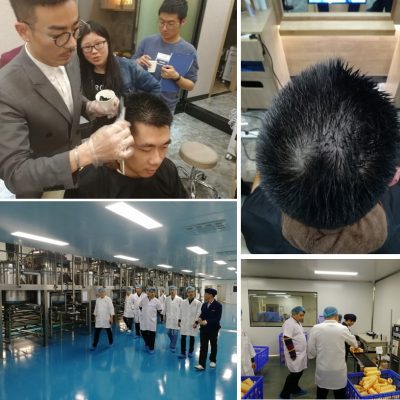Hair dye
At present, hair dyes on the market are mainly effective for dyeing hair with p-phenylenediamine, but they have many hazards. P-phenylenediamine is an internationally recognized chemical substance that is highly sensitized to humans; p-phenylenediamine is acutely toxic and irritating to human skin, and is easily absorbed by skin and hair to cause serious adverse reactions.
The color of the hair is determined by the melanin produced by melanocytes. The tyrosine in the body undergoes a series of reactions under the catalysis of the enzyme to form melanin.
Inspired by nature, we used a melanin precursor to prepare a green, non-toxic, non-p-phenylenediamine-containing melanin hair dye. The precursor molecules used are produced by the organism itself and are non-toxic and side-effect to the body. Achieved the hair dyeing effect of commercial hair dyes. In the figure, 1 row is the effect of washing 10, 20, 30 times after the dyeing of the melanin dyeing agent, and the second behavior is the comparison chart of the commercially available hair dye, and the 3rd and 4th rows are the effect diagrams of the dyeing of the melanin color hair dye.


Sunscreen
In recent years, with the gradual improvement of people’s health awareness, direct damage or potential damage of ultraviolet rays to the human body has attracted more and more attention and attention. Sunscreen is a convenient, suitable and universal choice for combating UV damage. Traditional sunscreens often rely on a variety of sunscreen additives to work together to attenuate solar radiation, including UV filters, antioxidants, and nanomaterial matrices. The problems caused by these complex components, such as phototoxicity, photostability, permeability and potential biotoxicity, have also become bottlenecks limiting their development. The idea of this artificial melanin sunscreen is derived from the natural melanin protection mechanism of the human body. The natural protective mechanism of the human body is naturally applied to the design of sunscreen, avoiding the photodegradation of organic ultraviolet absorbing materials in traditional sunscreen components. Causes the production of ROS, as well as adverse effects caused by skin penetration behavior. Resist UV damage while greatly improving light stability, no skin penetration behavior; inhibiting allergic reactions and secondary injuries. The product has a measured SPF value of more than 30, good skin adhesion, excellent waterproof performance and no irritation. It is a simple, efficient and safe new sunscreen product.




Electronic ink
Electronic ink is a smart material that changes the displayed image by the action of an electric field. This means that the electronic ink can be continuously applied to the surface of a certain medium to continuously display the displayed information. Currently, the main use of the microcapsules on the market is microcapsules. Electronic ink, due to its large size, has a low resolution and a complicated process. We used polydopamine nanoparticles as electronic ink to increase resolution by a factor of 33. The polydopamine nanoparticles have a negative potential and are uniform in size (150 nm) and can be stably dispersed in an aqueous solution without the addition of a surfactant. In addition, oxidized polydopamine nanoparticles are self-fluorescent and have unique fluorescence imaging properties at the nanoscale. The current electronic nano-ink devices are environmentally friendly and have low energy consumption, and have wide application value in high-definition resolution display, bio-fluorescence imaging and molecular patterns.
The picture shows the working principle of electronic ink.
